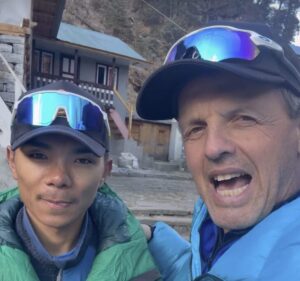Jost Kobusch is temporarily on his way back in civilization after two first ascents, as he acclimatizes for winter Everest.
“I am doing very well,” he told ExplorersWeb. “The training in Chamonix has really paid off, and I am feeling strong, healthy, and super-motivated — hohooo!”
He is happy because his acclimatization plans came to fruition. His main goal in the Annapurna region was the unclimbed 6,500m Purbung.
“There are several spellings (Putung, Purgpung), since the name of the peak, like many others in Nepal, was first transmitted orally. After completing its first ascent, I am going to stick to my favorite version: Purbung.”

Nicolas Scheidtweiler and Jost Kobusch, checking the maps. photo: Jost Kobusch’s FB
For this acclimatization phase, he teamed up with Nicolas Scheidtweiler, whom he had met some years ago when Kobusch was guiding New Guinea’s Carstensz Pyramid (Puncak Jaya).
Seven river crossings
The route starts at Thorong Pedhi, a lodge before the famous Thorong La Pass, on the Annapurna circuit.
“We followed the river, which we had to cross seven times, to a crack in the rock carved by the water,” said Kobusch.
From there, the climbers mounted to a gravel plateau, then had easy scrambling over some rocky steps to their Camp 1 at 5,100m.

A crack in the rock leads to a plateau. Photo: Jost Kobusch
“From there, some easy snow climbing followed, then a (very!) long traverse in front of a big icefall, where we set C2 at 5,400m,” Kobusch said.
The following day, the pair climbed through the icefall and up some small ice pillars (which he graded WI2). They then crossed the upper glacier until 5,850m, where they set Camp 3 below a little col.

Photo: Nicolas Scheidtweiler
From C3, we crossed the col and descended into a remote valley. From there, we followed the glacier onto the West Ridge of Purbung. Climbing the ridge was not technically difficult but it did include some steeper steps of up to 55º. We descended from the summit down the East Ridge. We reached the camp 14 hrs 15 mins after setting off.
One more
The next morning, Kobusch woke early and summited a second 6,000’er nearby. It was a quick climb, just an hour and a half up and half an hour down.
“This was also an unclimbed peak, 6,125m, and still unnamed,” said Kobusch.

Photo: Nicolas Scheidtweiler
He did not decide to climb Purbung spontaneously. Kobusch had the peak in mind since he first saw it in 2019 while acclimatizing for his first Everest attempt.
“At that time, I had two choices and went for Amosang,” Kobusch said. “Purbung was a bit higher and more remote, so I saved it for this time. Luckily, it has remained unclimbed, for good reason. It’s an extremely long approach and a very long climb. Finding the easiest way up takes a lot of time and endurance.”
Kobusch describes the weather as “autumn-like, mainly sunny and very windy”.
“During the climb, we had some snowfall but not much. But right after we summited, we had a massive snowfall — 20 to 30cm of snow on the trek back.”
Plans
The climbers are now trying to get out of the Annapurna region. “We hoped to get a Jeep tomorrow, but because of recent heavy snowfall, we might get stuck for a couple of days here (near Manang), since the roads are so muddy.”
He’ll return briefly to Kathmandu to sort out gear, then leave for Everest as soon as possible. “Instead of flying to Lukla, I will hike, which means I’ll need some extra days,” he explained. “The goal is to start [the Everest climb] on December 22, at the beginning of the astronomical winter, and to finish by the end of meteorological winter on February 28. It’s the same time window as last year.”
This time, Kobusch will bring only a cook with him to Everest. He will set up his headquarters in Lobuche.
Currently, he is unsure about the conditions on the mountain. “A big cyclone hit the region three weeks ago, which is good,” he said. “Hopefully, it covered the mountain in snow so I will not find it as dry as last time when I had problems with the windslab and blue, hard ice.
“Snow would make the climb easier, so I hope for more of it.”
Note: We will update this story tomorrow with pictures from his climb. It was late in Nepal by the time we conducted the interview, so Kobusch offered to send photos after a good night’s sleep.






